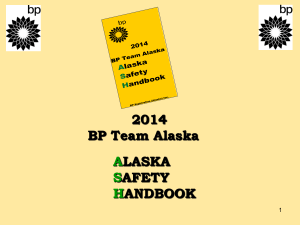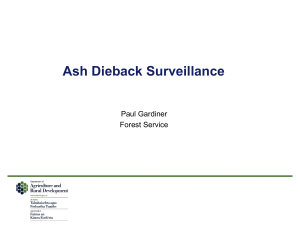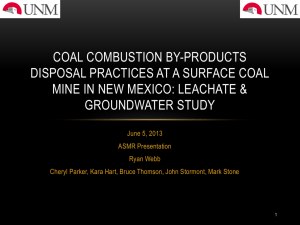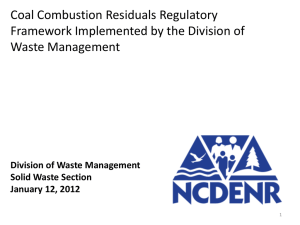Coal Ash Update - Elizabeth Werner - nc
advertisement
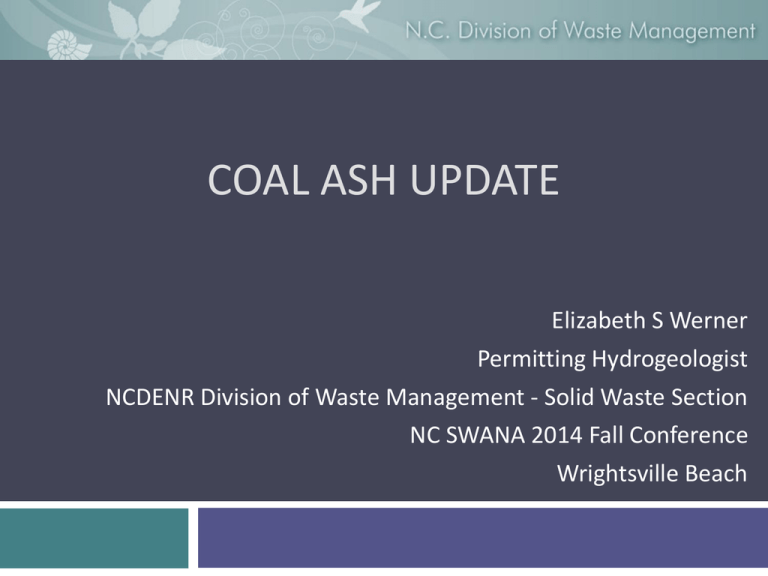
COAL ASH UPDATE Elizabeth S Werner Permitting Hydrogeologist NCDENR Division of Waste Management - Solid Waste Section NC SWANA 2014 Fall Conference Wrightsville Beach Coal Combustion Products (CCPs) Fly Ash - powdery material composed mostly of silica with nearly all particles being spherical captured in air pollution control systems Bottom Ash - large particles such as sand and small rocks from pulverizing coal and collected in the bottom of the boilers/furnace Flue Gas Desulfurization (FGD) Material - powdery material with a mixture of sulfites & sulfates (aka gypsum) produced when reducing SO2 emissions Boiler Slag - molten bottom ash which fractures and crystallizes to form hard black pellets when quenched with water Coal Ash Definitions As defined under 130A-290.(a)(35) – the definition of solid waste has been modified to include coal ash removed from ash ponds Wet ash (a.k.a. ash ponds) is regulated by the Division of Water Resources (formerly Water Quality) Dry ash (a.k.a. coal ash landfills) is regulated by the Division of Waste Management-Solid Waste Section Coal Combustion Products (CCP) = materials that are beneficially reused, including use for structural fill Coal Combustion Residuals (CCR) = materials that are disposed Coal Ash Landfills in NC 11 permitted landfills 10 associated with Duke Energy Progress (2 formerly Progress Energy) 1 associated with Roanoke Valley Energy 2 closed/inactive and unlined 9 open/active 6 single composite lined 3 double composite lined 3 overtop of retired ash ponds Coal Ash Landfills by Permit • • • • • • • Marshall Steam Station (Catawba County) • 1804-INDUS-1983: Dry Ash Landfill (closed, unlined) • 1809-INDUS: FGD Landfill (active, lined) • 1812-INDUS-2008: Landfill #1 (active, double lined) Allen Steam Station (Gaston County) • 3612-INDUS-2008: Retired Ash Basin Landfill (active, double lined) Roanoke Valley Energy Plant – Halifax County • 4204-INDUS-1994: Halifax County Coal Ash Landfill (active, lined) Roxboro Steam Plant (Person County) • 7302-INDUS-1988: CCB Landfill (active, lined) Mayo Steam Plant (Person County) • 7305-INDUS: CCP Monofill (active, double lined) Cliffside Steam Station (Rutherford County) • 8106-INDUS-2009: CCP Landfill (active, lined) Belews Creek Steam Station (Stokes County) • 8503-INDUS-1984: Pine Hall Rd Landfill (closed, unlined) • 8504-INDUS: Craig Rd Landfill (active, lined) • 8505-INDUS: FGD Landfill (active, lined) Recent Permit Activities 1804_Marshall_DryAsh - Closure Permit issued Dec 6, 2013 1809_Marshall_FGD - PTO modification for chimney drained issued Dec 6, 2013 1812_Marshall_LF#1 - PTC for Phase 1, Cells 3&4 issued Dec 6, 2013 7302_Roxboro - PTC for Phase 6 issued Oct 8, 2013 7305_Mayo PTC for Phase 1 issued July 19, 2012 PTO for Phase 1 issued July 10, 2014 8106_Cliffside - PTC for Phase 2 issued Sept 6, 2012 8504_BelewsCreek_CraigRd - PTC for Phase 2 issued May 18, 2012 Location of Coal Fired Power Plants Coal Ash Landfill Locations 2013-2014 Coal Ash Production & Disposal Facility Ash Tons Produced FGD Tons Produced Ash Tons Disposed FGD Tons Disposed Ash Tons in Structural fill Ash Tons Other Uses Gypsum Tons Other Uses Allen Steam Station 178,540 88,254 239,160 4,347 0 0 83,060 Belews Creek Steam Station 543,902 389,226 198,052 262,990 0 293,820 146,361 Buck Steam Station 0 0 0 0 0 0 0 Cliffside Steam Station 235,747 219,354 192,691 135,219 0 1,509 92,412 Dan River Steam Station 0 0 0 0 0 0 0 Marshall Steam Station 452,206 369,968 381,082 28,418 132 15,192 327,373 Riverbend Steam Station 0 0 0 0 0 0 0 Asheville Steam Station 0 84,495 0 1,081 0 0 83,414 Mayo Steam Plant 144,674 138,499 108,739 383 0 35,935 138,116 Roxboro Steam Plant 662,522 427,472 542,806 0 26,024 93,692 427,472 Totals 2,217,591 1,717,268 1,662,530 432,438 26,156 440,148 1,298,208 Beneficial Uses of Coal Ash in NC Drywall industry utilizes gypsum (FGD material) as a supplemental ingredient in the wallboard production process CertainTeed (wallboard production) recently opened a facility across the river from the Roxboro Power Plant Duke has reported an increased need for gypsum 8505-INDUS (Belews Creek - FGD) has been mining gypsum for the past 12 months Fly ash can be used as raw material for concrete products and a component in road bases Cenospheres - formed when coal combustion ash in molten form is rapidly quenched with water and “freezes” the ash into tiny spheres with trapped air/gas inside Harvested from ash ponds because they float Perfectly spherical and inert Used to make bowling balls and facial cleansers Session Law 2014-122 (Senate Bill 729) Overview Prohibit recovery of cost Moratorium on certain rate cases Create coal ash management commission Expedited review of permits Require quarterly reports on ash ponds to be submitted to the G.A. Prohibit local government regulation of management of CCPs Prohibit new construction or expansion of ash ponds, effective Oct 1, 2014 Prohibit disposal of CCPs to ash ponds at plants no longer producing CCPs, effective Oct 1, 2014 Prohibit stormwater discharge to ash ponds, effective Dec 31, 2019 Require all plants to convert to dry fly ash by Dec 31, 2018 and dry bottom ash by Dec 31, 2019 Overview continued… Require groundwater assessments for all ash ponds Require corrective action at ash ponds to restore GW quality Require survey of drinking water wells and replace contaminated water supplies Identify, assess and correct any unpermitted discharges from ash ponds By Dec 31, 2015 prioritize the closure and remediation of all ash ponds Owners to submit closure plans for all ash ponds Closure and remediation of certain ash ponds by Aug 1, 2019 Require DENR to establish a schedule for closure and remediation of ash ponds Establish minimum statutory requirements for structural fills and perform an inventory and inspect certain structural fills Moratorium on structural fills until Aug 1, 2015 and direct DENR to study adequacy of current law Overview continued… Moratorium on construction and expansion of landfills on top of retired ash ponds until Aug 1, 2015 and direct DENR to perform a study Strengthen reporting and notification requirements of discharges to waters of the state Require certain emergency calls to be recorded Require emergency action plans at high and intermediate hazard dams Transfer SW rule making authority from Public Health Commission to Environmental Management Commission Amend compliance boundary provisions Provide various studies Require the State Construction Office and DOT to develop technical specifications for beneficial use of CCBs Provide resources to implement this bill Part 11. SECTION 3.(b) Closure of Certain Ash Ponds The following ash ponds are deemed high-priority and shall close by Aug 1, 2019 Dan River Steam Station (Rockingham County) Riverbend Steam Station (Gaston County) Asheville Steam Plant (Buncombe County) Sutton Plant (New Hanover County) Part 11. 130A-309.212 Closure of CCP Ash Ponds By Dec 31, 2019 high risk ash ponds shall be closed with a closure plan submitted by Dec 31, 2016 By Dec 31, 2024 intermediate risk ash ponds shall be closed with a closure plan submitted by Dec 31, 2017 By Dec 31, 2029 low risk ash ponds shall be closed with a closure plan submitted by Dec 31, 2018 Part III. SECTION 4.(b) Moratorium on Structural Fills The use of CCPs as structural fill is prohibited until Aug 1, 2015 However, CCPs may be used as structural fill under two conditions: The fill is constructed with a base liner, leachate collection system and cap liner or groundwater monitoring system AND establishes financial assurance The fill is used as base or sub-base of a concrete or asphalt paved road constructed under the authority of a public entity Part 111. SECTION 4.(d) Study of Structural Fills DENR and Environmental Management Commission shall jointly perform a study on the use of CCPs in structural fills and jointly report to the Environmental Review Commission by Jan 15, 2015 Review the new statutory regulations (130A-309.214 – .222) to determine if the requirements are sufficient to protect human and environmental health Review the old statutory regulations (15A NCAC 13B .1700 and 15A NCAC 02T .1200) to determine if the rules are sufficient to protect human and environmental health Evaluate additional opportunities for use of CCPs in structural fills and other beneficial uses that would reduce the volume of CCPs disposed in landfills while still protecting human and environmental health Monitor any actions by the USEPA Part 11. 130A-309.214 – 130A-309.222 New Regulation of CCP use as Structural Fill Effective after moratorium ends Aug 1, 2015 130A-309.214 - Applicability 130A-309.215 – Permit requirements 130A-309.216 - Design, construction and siting requirements 130A-309.217 – Financial assurance for large projects 130A-309.218 – Closure requirements 130A-309.219 – Recordation of projects 103A-309.220 – DOT projects 130A-309.221 – Inventory and inspection of certain structural fills 10A-309.222 – Amendments required to rules Brief Summary of Requirements of New Structural Fills Projects using less than 8,000 tons per acre or less than 80,000 tons total Provide same info as required under the current law 15A NCAC 13B .1703(a) Stricter design, construction and operation requirements under 130A-309.216(a) Final cover applied no later than 30 working days/60 calendar days after CCP placement has ceased under 130A-209.218(a) Record location and volume of CCP structural fill with the Register of Deeds if project used more than 1,000 cubic yards Projects using more than 8,000 tons per acre or more than 80,000 tons total A composite liner system, leachate collection system, final cap and groundwater monitoring system are required Financial assurance is required Stricter closure requirements under 130A-309.218(b) Recordation of location and volume in Register of Deeds Buffer Requirements for Structural Fills 50 feet between edge of waste and property boundary 300 feet between edge of waste and private dwelling or well 50 feet between edge of waste and bodies of surface water 4 feet between bottom of waste and seasonal high water table 50 feet between edge of waste and wetlands Cannot be located within a 100-year flood plain Part 111. SECTION 5.(a) and SECTION 5.(b) CCR Landfills on top of Ash Ponds SECTION 5.(a) – establishes a moratorium on the construction of new or the expansion of existing CCR landfills on top of retired ash ponds, as defined by G.S. 130A-290(2c) until Aug 1, 2015 SECTION 5.(b) – DENR shall evaluate each existing CCR landfill currently operating on top of retired ash ponds to determine the advisability of continued operation, assess the risk to human and environmental health and report to the ERC by Jan 15, 2015 Can a MSW landfill accept coal ash? Yes, with caveats Cannot be comingled with MSW waste May be placed in expansion cells/phases as a monofill Important Dates Oct 1, 2014 – new construction or expansion of existing CCR ash ponds is prohibited Oct 1, 2014 – disposal of CCRs in ash ponds at power plants that no longer produce CCRs is prohibited Dec 31, 2018 – discharge of stormwater into ash ponds at power plants that no longer produce CCRs is prohibited Dec 31, 2019 - discharge of stormwater into ash ponds at power plants that actively produce CCRs is prohibited Dec 31, 2018 – all power plants shall convert to dry fly ash disposal Dec 31. 2019 – all power plants shall convert to dry bottom ash disposal Coal Ash Contacts Ed Mussler – permitting branch head 919.707.8281 ed.mussler@ncdenr.gov Larry Frost – permitting engineer 828.296.4704 larry.frost@ncdenr.gov Elizabeth Werner – permitting hydrogeologist 919.707.8253 elizabeth.werner@ncdenr.gov Questions? Elizabeth S Werner Permitting Hydrogeologist Raleigh Central Office – Green Square 919.707.8253 elizabeth.werner@ncdenr.gov

